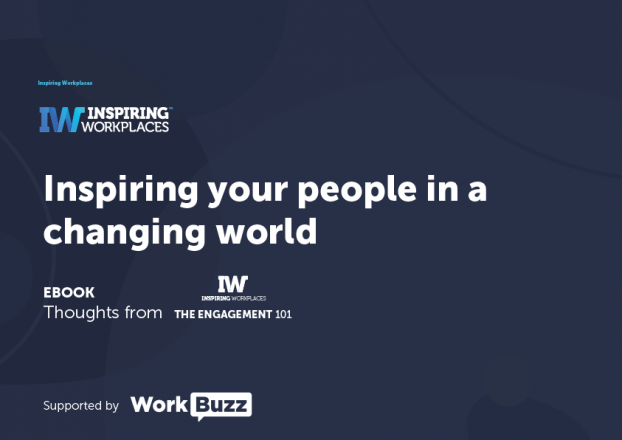
09th October 2023
Guest Post: New research reveals the impact of rewarding employees with experiences over things

About the author: Kevin Yip is co-founder and President at Blueboard, passionate about and focused on helping companies worldwide celebrate and recognize their top talent in a more meaningful way. Kevin has contributed to and been featured by Crunchbase, The HR Director, and the SalesTech SalesStar podcast.
I won’t sugarcoat it: Many leaders are seeing the impacts of disengaged employees on company culture and the performance of our business in real time—and there is urgency to do something about it.
Well-intentioned recognition in the form of stuff isn’t working (and isn’t sustainable when 40% of company swag ends up in landfills). Leaders need to do something meaningful, now, about the widening gaps in productivity and performance, a problem that recognition can effectively address. Something with staying power and long-term benefit for the business and our people, that they’ll enjoy so much they can’t help but rave about it to their peers, and personal and professional networks.
This sense of urgency is why we partnered with The Starr Conspiracy to get to the heart of what types of recognition and rewards are most valued by employees and most impactful for the organizations they’re loyal to. And what we found is both a cause for renewed optimism and a call for doubling down on the “how” of recognizing and rewarding our people. We surveyed more than 1,000 primarily U.S.-based employees and people leaders about different types of reward and recognition strategies and the impacts of these strategies. This research builds on a targeted study we ran last year for internal purposes on rewards and recognition preferences and perceptions on rewards and recognition preferences and perceptions among employees.
One of the most illuminating findings: Experience Leaders—or, companies that place the highest level of importance and investment in employee experience—who reward with experiences see nearly 4x the impact on employee engagement than those who don’t.
Below, we’ll explore our top three findings from this research, as well as some of our other key takeaways, on the most crucial employee experience (EX) levers companies can use to reinvigorate their company culture, re-engage their people, and celebrate and retain top performers.
1. Companies that invest in employee experience see significantly higher engagement.
The ingredients of a great employee experience are made up of many parts of employee-employer interactions from pre-recruitment to post-exit: major milestones, personal relationships, the technology we use, and physical work environment, to name a few.
What our research shows: companies prioritizing employee experience, aka Experience Leaders, outperform Laggards across four key employee experience indicators.

These indicators offer a detailed view into the ideal employee state of mind; one that drives engagement, performance, a better customer experience, and overall business success, including:
The stability of employment.
In an ongoing climate of inflation and economic uncertainty, financial security and job certainty are top priorities for employees. Employees who are satisfied with their pay and benefits are 26% more likely to have exceeded expectations at work and 13% more likely to continue working with their current employer for 3+ years. This sense of stability is essential to both employee satisfaction and long-term employee loyalty.
A two-way street: Employee-employer reciprocity.
When both parties in the employee-employer relationship deliver—a kind of social contract—this alignment drives better engagement. Over 40% of employees who are currently “quietly quitting” say greater employee-employer reciprocity (or, mutually beneficial) is an area of opportunity for their workplace. Meaningful, consistent recognition and stronger manager-employee relationships are both key tactics to foster this sense of reciprocity.
Thriving at work.
Having purpose at work combats stress and burnout and drives engagement and motivation. Employees who feel meaningfully connected to their work and their organization’s mission, vision, and values are less likely to report high levels of job stress. Values alignment is vital: employees who feel their organization embodies their values are 27% more likely to have higher engagement scores.
Employee optimism for their career.
Growth and development (commonly known as “learning and development, or L&D) is a big focus for employees, especially in younger generations. L&D is also a priority for workplace leaders who want to train effective managers, who are a lynchpin in a great employee experience.
While 64% of employees believe their career goals can be met at their organization, that number dropped between 2022 and 2023. This is a concerning trend because employees’ sense of whether they can grow with an organization has a huge impact on engagement and retention.
Of course, how organizations support employee experience and boost these indicators varies greatly. But taking a strategic approach to employee rewards and recognition are consistently shown to be a need-to-have pillar of cultivating a strong employee experience and workplace culture.
A Qualtrics’ Employee Experience Trends report found that among the most “move the needle” improvements companies can make to boost their employees’ desire to stay is to improve how they recognize and reward employee contributions.
To help take the guesswork out of which types of employee recognition and rewards to invest in, we’ll share in the next section at how EX leaders are strategically investing in employee rewards and recognition—and learnings you can leverage from them.
Which types of employee rewards have the biggest impact on employee experience? Our new research reveals them.
Send me the full research report
2. Rewards and recognition can’t be a “check the box” program; the more intentional the investment, the greater return.
Meaningful employee appreciation and effective recognition continuously surface as top drivers of a positive employee experience. The benefits for organizations and their people include:
- Increased employee engagement
- Stronger employee retention and loyalty
- More innovative thinking and appetite to exceed expectations at work
In fact, those who feel recognized at work are 2x more likely to report a willingness to go above and beyond their core job responsibilities. And our latest research further validates that companies that are prioritizing employee experience are also prioritizing strategic investment in employee rewards and recognition.
One of the most interesting findings from the data:
- EX leaders offer 31% more rewards than “Experience Laggards” (or, companies that haven’t yet harnessed the power of recognition to positively impact the employee experience and their business goals).
- There’s a significant correlation between the frequency of receiving recognition and rewards and employees’ sense of their organization’s commitment to and investment in employee experience.
- Employees at EX leader organizations were more likely to feel positively about the rewards they receive—and, to actually use, enjoy, and remember them (learn more about the specific power of experiences, the lasting memories they create, and amplifying your employee reward stories to maximize recognition program impact—what we call the post-experience “afterglow”).
Not only do these findings indicate that the more intentionally you invest in employee recognition and rewards, the greater return on performance, loyalty, and engagement; in order to best measure and track the impact of recognition program efforts, it needs to be tied to observable outcomes beyond the volume of rewards. (For more, check out The Blueboard Method™, our proprietary framework to support you in designing a program that promotes equitable appreciation across your organization and targeted rewards for top performers.)
3. Employers that invest in experiential rewards see more than 3x the impact per dollar spent.
The “how” is equally as important as nailing down why you want to recognize and reward employees. Our research shows that EX leaders are more likely to offer high personalization rewards—like experiences—instead of low personalization rewards, like gift cards, and points-based systems to redeem for consumer goods.
Why? The most effective employee rewards:
- Express effort and purpose on the part of the giver
- Evoke meaning, surprise, and delight on the part of the recipient

In fact, experiential rewards have 3.8x more impact on the employee experience than any other type of reward, including cash and gift cards.

Julia B. enjoys an epic mountain view while on a Blueboard experience, a reward from her employer in recognition of winning a quarterly sales incentive contest.
“I got to plan a trip for my whole family to go to Banff. It will be a trip we will never forget.” —Julia B., sales incentive contest winner and Blueboard reward recipient
3 reasons why experiential rewards are so much more impactful (and what this means for employers).
Experiential rewards shine a spotlight on milestone moments in the employee experience by giving people invaluable quality time outside of work. This gesture supports personalized employee fulfillment and growth by marking key moments in the employee journey with memorable experiences they get to enjoy outside of the office.
And the results are worth it: employers can boost an employee’s long-term engagement, performance, and loyalty. Here are three of the main reasons why experiences yield such tangible benefits and impact.
1. Experiential rewards give the gift of time to your people.
We live in an increasingly interconnected and busy world, where time is our most precious commodity. Rewarding an employee with an experience gives them quality time to invest more deeply in something they already love, or to try something they’ve always wanted to.
Just as employees give their time to their workplace, giving them back some time (one of our recommended best practices is to pair an experiential reward with time off to truly unplug and enjoy it) is a direct way to deliver on the reciprocity we mentioned earlier in this post.
2. Experiential rewards give your people something personalized to them.
Whether the reward sender is taking the time to curate an ideal experience for their employee or using Blueboard to send employees a menu of curated experiences they can choose from, the employee is getting a reward that is truly tailored to their interests and lifestyle.
This level of personalization makes employees feel seen as individuals and truly valued for their contributions—which is the primary outcome employees believe employer-provided rewards should drive.
3. Experiential rewards create space for employees to grow towards what’s most meaningful to them.
Beyond the in-the-moment joy you create when you recognize someone, experiences drive personal fulfillment and growth.
This is perhaps the most powerful aspect of experiential rewards: They allow employees to indulge in a passion or unlock a new skill, often in the company of the people they love most. Peoples’ identities are the sum of their experiences; as an employer, if you can have a hand in helping people shape their own identities and sense of success, you will drive longer-term loyalty and motivation.
Aside from the impact on individual employees, experiential rewards amplify the impact of a company’s recognition program through increased awareness because employees want to talk about their experiences.
Not only are people more likely to talk about their experiences than a material object or company swag, but hearing about other people’s experiences is less likely to evoke potentially detrimental social comparison, and foster a sense of cohesion and belonging. They think, “I want to try something new, or indulge in an existing passion. And if my peers can earn these, I can, too.” That’s the connective power of storytelling at its finest.
All of this awareness keeps the recognition program top-of-mind and appealing, and promotes a culture of performance.
EX Leaders put the “experience” in employee rewards.
Great employee experience is about many things, from offering comprehensive pay and benefits, to how an organization connects employees to purpose, to the processes and systems that support consistent, equitable employer-employee interactions.
Our research indicates that EX leaders are giving out a high volume and variety of rewards to balance building an always-on culture of appreciation and driving high performance. When it comes to rewarding employees for important milestones and/or triumphs, however, companies would benefit from using experiential rewards—better suited to driving key outcomes such as:
- Increased loyalty: Celebrate a particular milestone, like a work anniversary or major life event to show employees how much you value their long-term commitment
- Increased performance: Reward instances of high performance to encourage desired behaviors (ex: values-aligned behaviors, revenue-driving behaviors)
- Build a culture of high engagement and performance: Celebrate consistent top performers to drive continued motivation and encourage others to elevate performance
Meaningful employee rewards and recognition are one piece of the puzzle but, leveraged strategically, they can drive outsized impact on employee experience. For organizations committed to building a great employee experience—one that drives employee engagement, performance, and long-term loyalty—now’s the time to (re)examine your employee recognition and rewards strategy and consider how to amplify your programs with experiential rewards.
Got questions? Connect with a Blueboard recognition expert today to talk through your goals and discover what’s possible.





